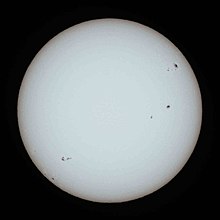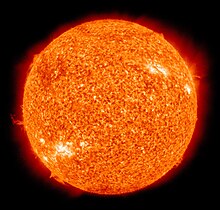Surya
Surya (simbol: ![]() ; Indonésia: Matahari, Inggris: Sun) ento bintang ané matongos di tengah tata surya, 1.496×108 km uli Gumi. Gobanné bunter[15] tur bentangné 1.392.684 km, kuang-lebih ping 109 bentang Guminé. Massané kuang-lebih 2×1030 kilogram, 330.000 ping massa Guminé. Surya malakar aji campuhan ané maadan "plasma"[16] ané malakar aji hidrogén (73%), hélium (25%), ajak oksigén, karbon, néon muah besi abedik.[17]
; Indonésia: Matahari, Inggris: Sun) ento bintang ané matongos di tengah tata surya, 1.496×108 km uli Gumi. Gobanné bunter[15] tur bentangné 1.392.684 km, kuang-lebih ping 109 bentang Guminé. Massané kuang-lebih 2×1030 kilogram, 330.000 ping massa Guminé. Surya malakar aji campuhan ané maadan "plasma"[16] ané malakar aji hidrogén (73%), hélium (25%), ajak oksigén, karbon, néon muah besi abedik.[17]
 Poto ring sunar kacingak manut saking filter surya ring warsa 2013 sané wénten titik surya miwah limb darkening. | |
 False-color potret kapotret ring warsa 2010 sané anggén cahaya ultraviolet (gelombang cahaya 30.4 nm) | |
| Data observasi | |
|---|---|
| Mean distance from Earth | 1 au ≈ 1.496×108 km[1] 8 min 19 s at light speed |
| Visual brightness (V) | −26.74[2] |
| Absolute magnitude | 4.83[2] |
| Spectral classification | G2V[3] |
| Metallicity | Z = 0.0122[4] |
| Angular size | 31.6–32.7 minutes of arc[5] |
| Adjectives | Solar |
| Orbital characteristics | |
| Mean distance from Milky Way core | ≈ 2.7×1017 km 27,200 light-years |
| Galactic period | (2.25–2.50)×108 yr |
| Velocity | ≈ 220 km/s (orbit around the center of the Milky Way) ≈ 20 km/s (relative to average velocity of other stars in stellar neighborhood) ≈ 370 km/s[6] (relative to the cosmic microwave background) |
| Physical characteristics | |
| Equatorial radius | 695,700 km,[7] 696,342 km[8] 109 × Earth[9] |
| Equatorial circumference | 4.379×106 km[9] 109 × Earth[9] |
| Flattening | 9×10−6 |
| Area permukaan | 6.09×1012 km2[9] 12,000 × Earth[9] |
| Volume | 1.41×1018 km3[9] 1,300,000 × Earth |
| Massa | 1.9884×1030 kg[2] 333,000 × Earth[2] |
| Average density | 1.408 g/cm3[2][9][10] 0.255 × Earth[2][9] |
| Center density (modeled) | 162.2 g/cm3[2] 12.4 × Earth |
| Equatorial surface gravity | 274 m/s2[2] 28 × Earth[9] |
| Moment of inertia factor | 0.070[2] (estimate) |
| Escape velocity (from the surface) | 617.7 km/s[9] 55 × Earth[9] |
| Suhu | Center (modeled): 1.57×107 K[2] Photosphere (effective): 5,772 K[2] Corona: ≈ 5×106 K |
| Luminosity (Lsol) | 3.828×1026 W[2] ≈ 3.75×1028 lm ≈ 98 lm/W efficacy |
| Color (B-V) | 0.63 |
| Mean radiance (Isol) | 2.009×107 W·m−2·sr−1 |
| Age | ≈ 4.6 billion years[11][12] |
| Karakteristik rotasi | |
| Obliquity | 7.25°[2] (to the ecliptic) 67.23° (to the galactic plane) |
| Right ascension of North pole[13] | 286.13° 19 h 4 min 30 s |
| Declination of North pole | +63.87° 63° 52' North |
| Sidereal rotation period (at equator) | 25.05 d[2] |
| (at 16° latitude) | 25.38 d[2] 25 d 9 h 7 min 12 s[13] |
| (ring kutub) | 34.4 d[2] |
| Kecepatan rotasi (ring ekuator) | 7.189×103 km/h[9] |
| Komposisi Photospheric (manut massa) | |
| Hidrogén | 73.46%[14] |
| Hélium | 24.85% |
| Oksigén | 0.77% |
| Karbon | 0.29% |
| Wesi | 0.16% |
| Néon | 0.12% |
| Nitrogén | 0.09% |
| Silikon | 0.07% |
| Magnésium | 0.05% |
| Urirang | 0.04% |
Pustaka
uah- ↑ Pitjeva, E. V.; Standish, E. M. (2009). "Proposals for the masses of the three largest asteroids, the Moon–Earth mass ratio and the Astronomical Unit". Celestial Mechanics and Dynamical Astronomy (ring Inggris). 103 (4): 365–372. doi:10.1007/s10569-009-9203-8. ISSN 1572-9478.
- ↑ 2,00 2,01 2,02 2,03 2,04 2,05 2,06 2,07 2,08 2,09 2,10 2,11 2,12 2,13 2,14 2,15 Williams, D.R. (1 July 2013). "Sun Fact Sheet". NASA Goddard Space Flight Center. Kaarsipin saking versi asli tanggal 15 July 2010. Kaaksés 12 August 2013.
- ↑ Zombeck, Martin V. (1990). Handbook of Space Astronomy and Astrophysics 2nd edition. Cambridge University Press.
- ↑ Asplund, M.; Grevesse, N.; Sauval, A.J. (2006). "The new solar abundances – Part I: the observations". Communications in Asteroseismology. 147: 76–79. Bibcode:2006CoAst.147...76A. doi:10.1553/cia147s76.
- ↑ "Eclipse 99: Frequently Asked Questions". NASA. Kaarsipin saking versi asli tanggal 27 May 2010. Kaaksés 24 October 2010.
- ↑ Hinshaw, G.; et al. (2009). "Five-year Wilkinson Microwave Anisotropy Probe observations: data processing, sky maps, and basic results". The Astrophysical Journal Supplement Series. 180 (2): 225–245. arXiv:0803.0732. Bibcode:2009ApJS..180..225H. doi:10.1088/0067-0049/180/2/225.
- ↑ Mal:Cite arxiv
- ↑ Emilio, Marcelo; Kuhn, Jeff R.; Bush, Rock I.; Scholl, Isabelle F. (2012), "Measuring the Solar Radius from Space during the 2003 and 2006 Mercury Transits", The Astrophysical Journal, 750 (2): 135, arXiv:1203.4898, Bibcode:2012ApJ...750..135E, doi:10.1088/0004-637X/750/2/135
- ↑ 9,00 9,01 9,02 9,03 9,04 9,05 9,06 9,07 9,08 9,09 9,10 9,11 "Solar System Exploration: Planets: Sun: Facts & Figures". NASA. Kaarsipin saking versi asli tanggal 2 January 2008.
- ↑ Ko, M. (1999). Elert, G. (ed.). "Density of the Sun". The Physics Factbook.
- ↑ Bonanno, A.; Schlattl, H.; Paternò, L. (2002). "The age of the Sun and the relativistic corrections in the EOS". Astronomy and Astrophysics. 390 (3): 1115–1118. arXiv:astro-ph/0204331. Bibcode:2002A&A...390.1115B. doi:10.1051/0004-6361:20020749.CS1 maint: ref=harv (link)
- ↑ Connelly, JN; Bizzarro, M; Krot, AN; Nordlund, Å; Wielandt, D; Ivanova, MA (2 November 2012). "The Absolute Chronology and Thermal Processing of Solids in the Solar Protoplanetary Disk". Science. 338 (6107): 651–655. Bibcode:2012Sci...338..651C. doi:10.1126/science.1226919. PMID 23118187.(Patut kacatet)
- ↑ 13,0 13,1 Seidelmann, P.K.; et al. (2000). "Report Of The IAU/IAG Working Group On Cartographic Coordinates And Rotational Elements Of The Planets And Satellites: 2000". Kaarsipin saking versi asli tanggal 14 May 2019. Kaaksés 22 March 2006.
- ↑ "The Sun's Vital Statistics". Stanford Solar Center. Kaaksés 29 July 2008. Citing Eddy, J. (1979). A New Sun: The Solar Results From Skylab. NASA. p. 37. NASA SP-402. Kaarsipin saking versi asli tanggal 2021-07-30. Kaaksés 2020-02-27.
- ↑ "How Round is the Sun?". NASA. Kaarsipin saking versi asli tanggal 2018-09-17. Kaaksés 2019-06-18.
- ↑ "First Ever STEREO Images of the Entire Sun". NASA. Kaarsipin saking versi asli tanggal 2011-03-08. Kaaksés 2019-06-18.
- ↑ Basu, S.; Antia, H.M. (2008). "Helioseismology and Solar Abundances". Physics Reports. 457 (5–6): 217–283